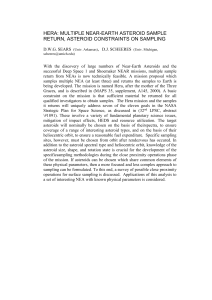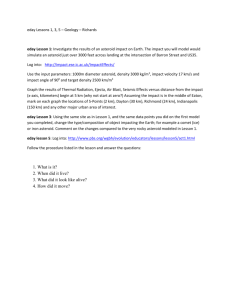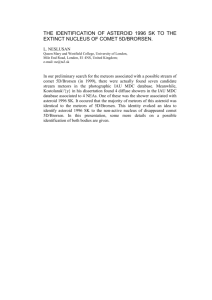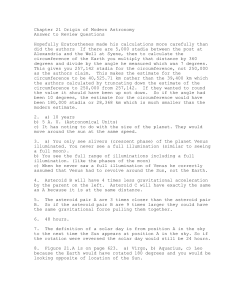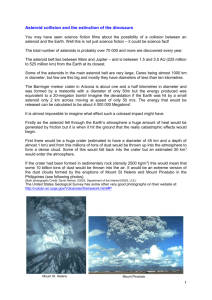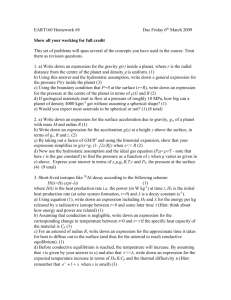Observations - Department of Physics, HKU
advertisement
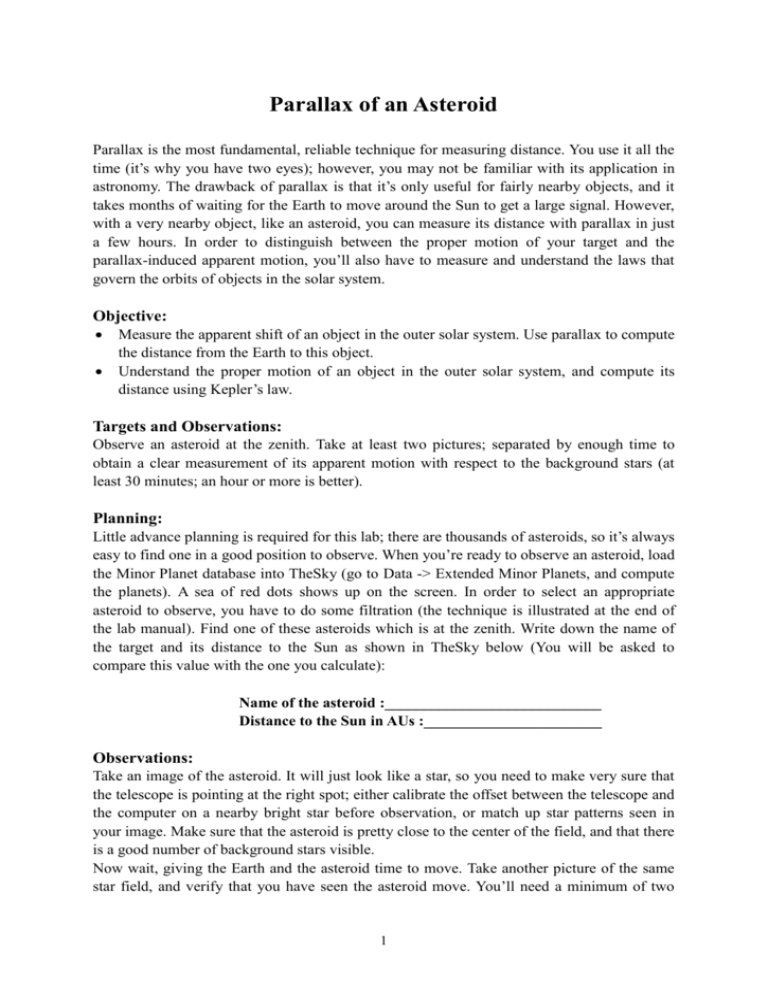
Parallax of an Asteroid Parallax is the most fundamental, reliable technique for measuring distance. You use it all the time (it’s why you have two eyes); however, you may not be familiar with its application in astronomy. The drawback of parallax is that it’s only useful for fairly nearby objects, and it takes months of waiting for the Earth to move around the Sun to get a large signal. However, with a very nearby object, like an asteroid, you can measure its distance with parallax in just a few hours. In order to distinguish between the proper motion of your target and the parallax-induced apparent motion, you’ll also have to measure and understand the laws that govern the orbits of objects in the solar system. Objective: Measure the apparent shift of an object in the outer solar system. Use parallax to compute the distance from the Earth to this object. Understand the proper motion of an object in the outer solar system, and compute its distance using Kepler’s law. Targets and Observations: Observe an asteroid at the zenith. Take at least two pictures; separated by enough time to obtain a clear measurement of its apparent motion with respect to the background stars (at least 30 minutes; an hour or more is better). Planning: Little advance planning is required for this lab; there are thousands of asteroids, so it’s always easy to find one in a good position to observe. When you’re ready to observe an asteroid, load the Minor Planet database into TheSky (go to Data -> Extended Minor Planets, and compute the planets). A sea of red dots shows up on the screen. In order to select an appropriate asteroid to observe, you have to do some filtration (the technique is illustrated at the end of the lab manual). Find one of these asteroids which is at the zenith. Write down the name of the target and its distance to the Sun as shown in TheSky below (You will be asked to compare this value with the one you calculate): Name of the asteroid :____________________________ Distance to the Sun in AUs :_______________________ Observations: Take an image of the asteroid. It will just look like a star, so you need to make very sure that the telescope is pointing at the right spot; either calibrate the offset between the telescope and the computer on a nearby bright star before observation, or match up star patterns seen in your image. Make sure that the asteroid is pretty close to the center of the field, and that there is a good number of background stars visible. Now wait, giving the Earth and the asteroid time to move. Take another picture of the same star field, and verify that you have seen the asteroid move. You’ll need a minimum of two 1 pictures (strongly recommended three or more pictures), separated by about an hour or more. If you like, you can take more pictures in the interval between, or afterwards, to create a movie of the asteroid’s apparent motion. Analysis: While the observations for this lab are pretty easy, the data analysis winds up getting a bit complicated. Keep a few things in mind: All distances should be measured in astronomical units (AUs). Do not convert anything to meters, kilometers, light years, or parsecs, unless you want a headache. All times should be measured in years; this may require you to convert the time between your observations from minutes to years, but it simplifies the math. The key is a good diagram – ask your tutor for help. First, make sure you understand what are the measurements and what you are looking for. The diagram below shows schematically what parallax is about. P m T2 e Asteroi T1 1 AU Star Earth Sun 2 e : m: p : the distance the Earth moved between observations; the measured distance from the Earth to the asteroid the parallax angle Because the time between our observations was very short compared to a year, we can ignore the curvature of the Earth’s orbit. We’re also assuming that the asteroid's orbit is in the same plane with the Earth. Calculation: You first need to work out the plate scale of the images, i.e. how many arcseconds in the sky does 1 pixel correspond to? Given that the telescope has 16 diameter and f/8.4, and the CCD has pixel size of 9microns. First study the images you took of an asteroid. Align the first and last images you took (techniques of stacking images is illustrated in the end of the lab manual). Measure how far the asteroid moves in pixels. Convert this to apparent angular shift P, in arcseconds, using the telescope’s plate scale. Show your calculation below: Measure how much time passed between your two images, in seconds: __________________ Convert this to fraction of a year: _______________________ Now compute the distance (in AU) the Earth moved in its path around the Sun in between your two images, assuming that the Earth’s orbit is a circle with radius = 1 AU. This is denoted by e. If you assume the asteroid was not moving in between your two pictures, what is the distance from the Earth to the asteroid (m)? 3 But, of course, the asteroid was moving in between your two images, and this fact will throw off the distance you calculated above. Is your answer too large, or too small? Modify the parallax diagram to show what’s really going on by including the asteroid’s motion. On the modified diagram, label the following quantities: a : d : the distance the asteroid moved between observations the true distance from the Earth to the asteroid Now look at the geometry of your diagram. Write down an equation that will let us to calculate d in terms of e, a, and m. Now the problem is that we cannot solve this equation unless we know a. The trick is to use Kepler’s Third Law of planetary motion, which states that objects farther from the Sun move more slowly through their orbits, and thus take a longer time to complete one orbit. To be precise, Y2 = R3, for any solar system object (like a planet or asteroid), where Y is the orbital period and R is the radius of its orbit. (Note that this form of the equation only works if you use the right 4 units for distance and time; note also that, for the Earth, Y=1 and R=1, so the equation works just fine.) Using Kepler’s third law and some geometry, write down an equation that will let us to solve for a in terms of d and e: Now we have two equations, and two unknown quantities (a and d). Use the second equation to replace a in the first equation, so that you have one equation that contains only d and m whose values you already know: Now use the quadratic formula to solve this equation for d: You will have two values of d. Reject the unreasonable one and explain why. Also, compare d with m, what is the effect while considering the asteroid's proper motion? 5 Image Printout: Finally, show your stacked image below, indicate the movement of the asteroid. Below is an example for you to follow: You should mark down the name of the asteroid, the date of the image, the exposure time and the number of images you stack. Also indicate the direction of motion. 6 Appendix Techniques: (1) Locate an asteroid in TheSky 6: Data -> Extended Minor Planets, and compute the planets: Also, go to Data-> Comets and Minor Planets: 7 Select all the minor planets and click OK. You better choose an asteroid of magnitude above 13, you can filter the asteroids in TheSky setting: View -> Display Explorer -> Solar system -> Minor Planet -> Display properties: In the Magnitude limits: Input 13 in the Faintest field. Click OK. Also go to View -> Display Explorer -> Solar system -> Extended Minor Planet -> Display properties, type 13 in the Faintest field. Click OK. Go to View -> Display Explorer -> Solar system -> Extended Minor Planet -> Labels, check Magnitude. Then the magnitude of asteroids will show in TheSky 6. 8 (2) Measure the length in pixels in MaxIm DL: Left click the star you want to measure. Be sure the cursor circle the star spot. In the information window, mark down the Centroid (X1,Y1) for Star 1. Do the same for Star 2 (X2,Y2). The length in pixels between Star 1 and Star 2 is √(𝑋1 − 𝑋2 )2 + (𝑌1 − 𝑌2 )2 . (3) Check the observation time with MaxIm DL: 9 Open the image in MaxIm DL. Go to View -> FITS Header Window or shortcut key Ctrl + F, the FITS Header window will pop up as shown below, check the time of the image taken in DATE-OBS. Please notice that the time shown is UTC. (4) Exposure time For asteroids with Magnitude ~ 12, exposure time should be around 20s. Double check the focus of the telescope before you take images. (5) Stacking in MaxIm DL Open all the images you want to stack in MaxIm DL. Go to Process -> Stack. Click Add Images, then click add all. 10 After adding images, click the Align Tab. Choose Manual 2 Stars in Mode. Check Use Centroid and Auto Next. Then you can start to align images. Zoom in the images to choose 2 stars (excluding the asteroid of course) which are best at the two corners at the diagonal line of the images. These are the 2 stars you use to align images. Then Click the first image in the Goup 1 window. Move the cursor to Star 1 in the image, left click to mark the position of Star 1. There is "1" showing near the cursor, indicating you are marking Star 2 The image will change to next one automatically once you left click Star 1. After marking Star 1, the number near the cursor will change to "2". Do the same marking for Star 2. Then you finish alignment. Click the Combine Tap. Choose Sum in Combine Method. Notice that there are red crosses ahead the image names in the group information. Left click each red cross once to change it into red tick. 11 Then click Go. MaxIm DL will start stacking and a stacked image will show up. Save the stacked image. (6) Export JPEG file from FITS: In printing out your images, you may need export your images from FITS to JPEG. In MaxIm DL, go to File -> Save As. Choose JPEG Images in Save as type. Check Auto Stretch. Then click Save. 12


